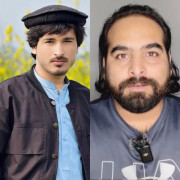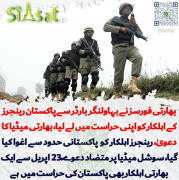C.I.A. and Pakistan Work Together, but Do So Warily
By MARK MAZZETTI and JANE PERLEZ
Published: February 24, 2010
Sign in to Recommend
ISLAMABAD, Pakistan Inside a secret detention center in an industrial pocket of the Pakistani capital called I/9, teams of Pakistani and American spies have kept a watchful eye on a senior Taliban leader captured last month. With the other eye, they watch each other.
Enlarge This Image
Pakistan Press Information Department, via Agence France-Presse Getty Images
Prime Minister Yousaf Raza Gilani, left, with Lt. Gen. Ahmad Shuja Pasha, the director of Pakistan's intelligence service.
Related
In Blow to Taliban, 2 More Leaders Are Arrested (February 19, 2010)
In Pakistan Raid, Taliban Chief Was an Extra Prize (February 19, 2010)
Secret Joint Raid Captures Talibans Top Commander (February 16, 2010)
Times Topics: Inter-Services Intelligence | Central Intelligence Agency | TalibanThe C.I.A. and its Pakistani counterpart, the Directorate of Inter-Services Intelligence, have a long and often tormented relationship. And even now, they are moving warily toward conflicting goals, with each maneuvering to protect its influence after the shooting stops in Afghanistan.
Yet interviews in recent days show how they are working together on tactical operations, and how far the C.I.A. has extended its extraordinary secret war beyond the mountainous tribal belt and deep into Pakistans sprawling cities.
Beyond the capture of Mullah Abdul Ghani Baradar, C.I.A. operatives working with the ISI have carried out dozens of raids throughout Pakistan over the past year, working from bases in the cities of Quetta, Peshawar and elsewhere, according to Pakistani security officials.
The raids often come after electronic intercepts by American spy satellites, or tips from Pakistani informants and the spies from the two countries then sometimes drive in the same car to pick up their quarry. Sometimes the teams go on lengthy reconnaissance missions, with the ISI operatives packing sunscreen and neon glow sticks that allow them to identify their positions at night.
Successful missions sometimes end with American and Pakistani spies toasting one another with Johnnie Walker Blue Label whisky, a gift from the C.I.A.
The C.I.A.s drone campaign in Pakistan is well known, which is striking given that this is a covert war. But these on-the-ground activities have been shrouded in secrecy because the Pakistani government has feared the public backlash against the close relationship with the Americans.
In strengthening ties to the ISI, the C.I.A. is aligning itself with a shadowy institution that meddles in domestic politics and has a history of ties to violent militant groups in the region. A C.I.A. spokesman declined to comment for this article.
Officials in Washington and Islamabad agree that the relationship between the two spy services has steadily improved since the low point of the summer of 2008, when the C.I.A.s deputy director traveled to Pakistan to confront ISI officials with communications intercepts indicating that the ISI was complicit in the bombing of the Indian Embassy in Kabul, Afghanistan.
The spy agencies have built trust in part through age-old tactics of espionage: killing or capturing each others enemies. A turning point came last August, when a C.I.A. missile killed the militant leader Baitullah Mehsud as he lay on the roof of his compound in South Waziristan, his wife beside him massaging his back.
Mr. Mehsud for more than a year had been responsible for a wave of terror attacks in Pakistani cities, and many inside the ISI were puzzled as to why the United States had not sought to kill him. Some even suspected he was an American, or Indian, agent.
The drone attack on Mr. Mehsud is part of a joint war against militants in Pakistans tribal areas, where C.I.A. drones pound militants from the air as Pakistani troops fight them on the ground.
And yet for two spy agencies with a long history of mistrust, the accommodation extends only so far. For instance, when it comes to the endgame in Afghanistan, where Pakistan hopes to play a significant role as a power broker, interviews with Pakistani and American intelligence officials in Islamabad and Washington reveal that the interests of the two sides remain far apart.
Even as the ISI breaks up a number of Taliban cells, officials in Islamabad, Washington and Kabul hint that the ISIs goal seems to be to weaken the Taliban just enough to bring them to the negotiating table, but leaving them strong enough to represent Pakistani interests in a future Afghan government.
This contrasts sharply with the American goal of battering the Taliban and strengthening Kabuls central government and security forces, even if American officials also recognize that political reconciliation with elements of the Taliban is likely to be part of any ultimate settlement.
Tensions in the relationship surfaced in the days immediately after Mullah Baradars arrest, when the ISI refused to allow C.I.A. officers to interrogate the Taliban leader. Americans have since been given access to the detention center. On Wednesday, Pakistani and Afghan officials meeting in Islamabad said that a deal was being worked out to transfer Mullah Baradar to Afghan custody, which could allow the Americans unrestrained access to him.
Besides Mullah Baradar, several Taliban shadow governors and other senior leaders have been arrested inside Pakistan in recent weeks.
A top American military officer in Afghanistan on Wednesday suggested that with the arrests, the ISI could be trying to accelerate the timetable for a negotiated settlement between the Taliban and the Afghan government.
I dont know if theyre pushing anyone to the table, but they are certainly preparing the meal, the officer said.
1 2
By MARK MAZZETTI and JANE PERLEZ
Published: February 24, 2010
Sign in to Recommend
ISLAMABAD, Pakistan Inside a secret detention center in an industrial pocket of the Pakistani capital called I/9, teams of Pakistani and American spies have kept a watchful eye on a senior Taliban leader captured last month. With the other eye, they watch each other.
Enlarge This Image
Pakistan Press Information Department, via Agence France-Presse Getty Images
Prime Minister Yousaf Raza Gilani, left, with Lt. Gen. Ahmad Shuja Pasha, the director of Pakistan's intelligence service.
Related
In Blow to Taliban, 2 More Leaders Are Arrested (February 19, 2010)
In Pakistan Raid, Taliban Chief Was an Extra Prize (February 19, 2010)
Secret Joint Raid Captures Talibans Top Commander (February 16, 2010)
Times Topics: Inter-Services Intelligence | Central Intelligence Agency | TalibanThe C.I.A. and its Pakistani counterpart, the Directorate of Inter-Services Intelligence, have a long and often tormented relationship. And even now, they are moving warily toward conflicting goals, with each maneuvering to protect its influence after the shooting stops in Afghanistan.
Yet interviews in recent days show how they are working together on tactical operations, and how far the C.I.A. has extended its extraordinary secret war beyond the mountainous tribal belt and deep into Pakistans sprawling cities.
Beyond the capture of Mullah Abdul Ghani Baradar, C.I.A. operatives working with the ISI have carried out dozens of raids throughout Pakistan over the past year, working from bases in the cities of Quetta, Peshawar and elsewhere, according to Pakistani security officials.
The raids often come after electronic intercepts by American spy satellites, or tips from Pakistani informants and the spies from the two countries then sometimes drive in the same car to pick up their quarry. Sometimes the teams go on lengthy reconnaissance missions, with the ISI operatives packing sunscreen and neon glow sticks that allow them to identify their positions at night.
Successful missions sometimes end with American and Pakistani spies toasting one another with Johnnie Walker Blue Label whisky, a gift from the C.I.A.
The C.I.A.s drone campaign in Pakistan is well known, which is striking given that this is a covert war. But these on-the-ground activities have been shrouded in secrecy because the Pakistani government has feared the public backlash against the close relationship with the Americans.
In strengthening ties to the ISI, the C.I.A. is aligning itself with a shadowy institution that meddles in domestic politics and has a history of ties to violent militant groups in the region. A C.I.A. spokesman declined to comment for this article.
Officials in Washington and Islamabad agree that the relationship between the two spy services has steadily improved since the low point of the summer of 2008, when the C.I.A.s deputy director traveled to Pakistan to confront ISI officials with communications intercepts indicating that the ISI was complicit in the bombing of the Indian Embassy in Kabul, Afghanistan.
The spy agencies have built trust in part through age-old tactics of espionage: killing or capturing each others enemies. A turning point came last August, when a C.I.A. missile killed the militant leader Baitullah Mehsud as he lay on the roof of his compound in South Waziristan, his wife beside him massaging his back.
Mr. Mehsud for more than a year had been responsible for a wave of terror attacks in Pakistani cities, and many inside the ISI were puzzled as to why the United States had not sought to kill him. Some even suspected he was an American, or Indian, agent.
The drone attack on Mr. Mehsud is part of a joint war against militants in Pakistans tribal areas, where C.I.A. drones pound militants from the air as Pakistani troops fight them on the ground.
And yet for two spy agencies with a long history of mistrust, the accommodation extends only so far. For instance, when it comes to the endgame in Afghanistan, where Pakistan hopes to play a significant role as a power broker, interviews with Pakistani and American intelligence officials in Islamabad and Washington reveal that the interests of the two sides remain far apart.
Even as the ISI breaks up a number of Taliban cells, officials in Islamabad, Washington and Kabul hint that the ISIs goal seems to be to weaken the Taliban just enough to bring them to the negotiating table, but leaving them strong enough to represent Pakistani interests in a future Afghan government.
This contrasts sharply with the American goal of battering the Taliban and strengthening Kabuls central government and security forces, even if American officials also recognize that political reconciliation with elements of the Taliban is likely to be part of any ultimate settlement.
Tensions in the relationship surfaced in the days immediately after Mullah Baradars arrest, when the ISI refused to allow C.I.A. officers to interrogate the Taliban leader. Americans have since been given access to the detention center. On Wednesday, Pakistani and Afghan officials meeting in Islamabad said that a deal was being worked out to transfer Mullah Baradar to Afghan custody, which could allow the Americans unrestrained access to him.
Besides Mullah Baradar, several Taliban shadow governors and other senior leaders have been arrested inside Pakistan in recent weeks.
A top American military officer in Afghanistan on Wednesday suggested that with the arrests, the ISI could be trying to accelerate the timetable for a negotiated settlement between the Taliban and the Afghan government.
I dont know if theyre pushing anyone to the table, but they are certainly preparing the meal, the officer said.
1 2




























